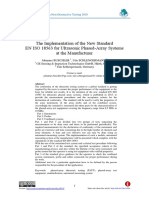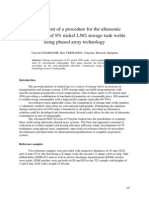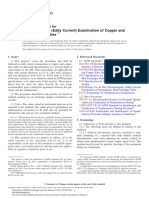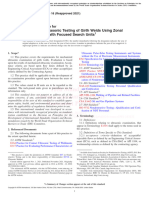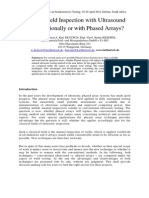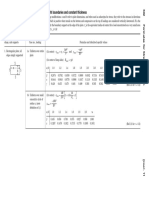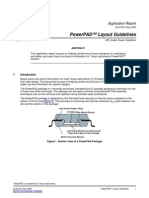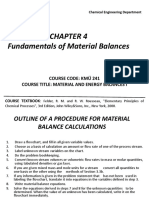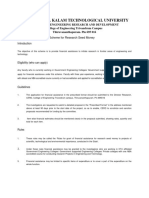0%(1)0% found this document useful (1 vote)
133 viewsQuick Flaw Evaluation in Ultrasonic Testing Using Microprocessor Assisted Methods
Quick Flaw Evaluation in Ultrasonic Testing Using Microprocessor Assisted Methods
Uploaded by
Gustavo ShawThis document summarizes two commonly used methods for evaluating ultrasonic testing results: the reference block method and the DGS (distance-gain-size) method. It describes how microprocessor-controlled ultrasonic instruments can simplify these methods by automatically applying necessary corrections and allowing direct evaluation of flaw indications against preset recording curves. Electronic implementation of the DGS method in particular is highlighted, avoiding errors through on-screen warnings and direct readout of evaluation results.
Copyright:
© All Rights Reserved
Available Formats
Download as DOCX, PDF, TXT or read online from Scribd
Quick Flaw Evaluation in Ultrasonic Testing Using Microprocessor Assisted Methods
Quick Flaw Evaluation in Ultrasonic Testing Using Microprocessor Assisted Methods
Uploaded by
Gustavo Shaw0%(1)0% found this document useful (1 vote)
133 views4 pagesThis document summarizes two commonly used methods for evaluating ultrasonic testing results: the reference block method and the DGS (distance-gain-size) method. It describes how microprocessor-controlled ultrasonic instruments can simplify these methods by automatically applying necessary corrections and allowing direct evaluation of flaw indications against preset recording curves. Electronic implementation of the DGS method in particular is highlighted, avoiding errors through on-screen warnings and direct readout of evaluation results.
Original Title
Dgs
Copyright
© © All Rights Reserved
Available Formats
DOCX, PDF, TXT or read online from Scribd
Share this document
Did you find this document useful?
Is this content inappropriate?
This document summarizes two commonly used methods for evaluating ultrasonic testing results: the reference block method and the DGS (distance-gain-size) method. It describes how microprocessor-controlled ultrasonic instruments can simplify these methods by automatically applying necessary corrections and allowing direct evaluation of flaw indications against preset recording curves. Electronic implementation of the DGS method in particular is highlighted, avoiding errors through on-screen warnings and direct readout of evaluation results.
Copyright:
© All Rights Reserved
Available Formats
Download as DOCX, PDF, TXT or read online from Scribd
Download as docx, pdf, or txt
0%(1)0% found this document useful (1 vote)
133 views4 pagesQuick Flaw Evaluation in Ultrasonic Testing Using Microprocessor Assisted Methods
Quick Flaw Evaluation in Ultrasonic Testing Using Microprocessor Assisted Methods
Uploaded by
Gustavo ShawThis document summarizes two commonly used methods for evaluating ultrasonic testing results: the reference block method and the DGS (distance-gain-size) method. It describes how microprocessor-controlled ultrasonic instruments can simplify these methods by automatically applying necessary corrections and allowing direct evaluation of flaw indications against preset recording curves. Electronic implementation of the DGS method in particular is highlighted, avoiding errors through on-screen warnings and direct readout of evaluation results.
Copyright:
© All Rights Reserved
Available Formats
Download as DOCX, PDF, TXT or read online from Scribd
Download as docx, pdf, or txt
You are on page 1of 4
At a glance
Powered by AI
The key takeaways are that two commonly used flaw evaluation methods are the reference block method and DGS method, and that using a microprocessor-controlled ultrasonic instrument can considerably simplify evaluation by automatically applying necessary corrections and directly displaying evaluation results.
The two commonly used flaw evaluation methods are the reference block method and the DGS (Distance-Gain Size) method.
The pros of the DGS method are that no reference blocks are required and evaluation is easy and reliable. The cons are that individual corrections must be graphically determined. The pros of the reference block method are that it contains all test-related influences and no corrections are needed. The cons are that a suitable reference block must be fabricated or procured and a DAC curve recorded for every test.
Quick Flaw Evaluation in Ultrasonic Testing
Using Microprocessor Assisted Methods
Dipl. Phys. Michael Berke
Contact to author
Abstract:
Even the commonly used flaw evaluation methods can be considerably simplified by the use of
microprocessor controlled ultrasonic instruments. This results in advantages such as saving of
time and increased test reliability.
Table of contents
Two methods
The DGS method.
Procedure
Electronic DGS evaluation
In nondestructive ultrasonic testing of materials, high frequency sound pulses (approx. 1 to 10
MHz) are beamed into the workpiece to be tested by means of a probe. The sound is reflected
from internal non homogeneities, e.g. a flaw in the material. These sound reflections are again
received by the probe and processed in the ultrasonic instrument. This is followed by the
evaluation of the signals (echoes), viz. with the standard methods on the basis of acoustic time of
flight and amplitude.
Two methods
Present day evaluation methods produce reliable and reproducible results providing that the
testing device meets technical requirements and that the test personnel are accordingly qualified.
The position of a flaw in the workpiece is calculated quickly and very accurately on the basis of
the measured acoustic time of flight of an echo. This means that a flaw location takes place. The
echo amplitude is used for an estimation of the flaw size. However, this is not quite as easy as
flaw location because the echo amplitude is subjected to much more influences than the acoustic
time of flight. Two methods have become generally accepted in manual ultrasonic testing
worldwide:
the reference block method and
the DGS method.
Though the two methods differ very much with regard to their application, they are not different
with regard to the physical principles of sound propagation and sound reflection that they are
based on. The reason is that, in both methods, the inspector determines the size (diameter) of a
reference reflector (disk shaped reflector, cylindrical reflector). The size thus determined is not
identical with the actual flaw size and it is therefore termed as the equivalent circular disk or side
drilled hole diameter. The shorter term "equivalent reflector size" (ERS) has become generally
accepted when using disk shaped reflectors. The reason for the fact that the actual flaw size does
not correspond to the equivalent reflector size is because the sound fractions reflected from a
natural flaw are additionally influenced by the shape, orientation and surface quality of the flaw.
In this respect further tests are difficult and not very practical in manual ultrasonic testing so that
most specifications and guidelines for ultrasonic testing attach the criteria for flaw recording to a
defined equivalent reflector size. This means: the inspector determines whether a detected flaw
reaches or exceeds the equivalent reflector size indicated as a limit value (recording level) in the
standard specifications. In addition to this, the inspector must carry out other tests, e.g. regarding
the recording length, echo dynamics, etc., further details of which are not discussed here.
DGS diagram
The regularities of sound propagation in material have been
theoretically known for a long time and were confirmed in practice by
numerous experiments. The development of modern evaluation
methods shows two ways. With the reference block method the
characteristic curve of the sound field is always determined before
carrying out an ultrasonic test, whereas in the DGS method DGS
diagrams for probes are applied for this. A DGS diagram shows the
echo amplitudes of disk shaped reflectors with different diameters and those of large, flat
reflectors (backwall) as a function of the distance Fig.1 DGS Diagram.
Procedure
To understand this better, let us start by explaining the sequences for both evaluation methods at
this point.
The reference block method requires that a reference block, corresponding to the test
object and containing one or more reference reflectors, be available for the test. The
distance dependence of echo amplitudes is determined experimentally by means of
drilled holes in the reference block, the resulting curve is then transmitted to the screen
display of the test instrument (DAC Distance Amplitude Correction). This curve
automatically includes all probe (sound field) and material effects. The test object can
now be scanned with the probe. An indication recording is made when an echo reaches
the DAC curve or exceeds it.
A prerequisite with the DGS method is that the corresponding DGS diagram be
available for the probe used in the test application. The reference gain of the test
instrument, with which the reference echo is at a fixed screen height (reference level), is
determined for a specific reflector, i.e. the reference reflector. After this, the instrument
gain is increased by a certain value, i.e. the test sensitivity is adjusted. If the reference
reflector is a circular arc from one of the standardized calibration blocks, then the
instrument gain should be varied in accordance with the correction value given for the
angle beam probe: the amplitude correction value is adjusted. With different surface
qualities between the test object and the calibration block the transfer correction must be
determined experimentally and likewise taken into consideration. The gain difference
with regard to the reference echo is determined for the maximum echo from a detected
indication. This is followed by a graphic determination of the equivalent reflector size
using the DGS diagram. If required, the sound attenuation correction is additionally
carried out. This makes it possible to assess whether the indication is to be recorded or
not. Nevertheless, by using the DGS scale it is possible to significantly simplify
evaluation with the DGS method (Fig.2).
Fig. 2 Evaluation using a DGS scale.
In this connection, the inspector uses an attachment scale for the screen of
the ultrasonic instrument. This scale contains one or several ready made
recording curves. The tiresome graphic evaluation with the DGS diagram
can thus be omitted. The inspector can directly assess flaw indications by
means of the curve.
A comparison of the test sequences for the reference block method and DGS method shows the
pros and cons in this table.
Pros and cons of the DGS and reference block method
Refernce block methode DGS-method
Pros
The DAC curve contains all test-
related
Influences, i.e. no time-consuming
corrections are recuired.
Easy and reliable evaluation.
No reference blocks required.
Cons
Fabrication or procurement of a
suitable reference block.
Recording of a DAC curve for every
test application
Measurement and consideration of different
individual corrections.
Graphic determination of the equivalent reflector
size.
Electronic DGS evaluation
The use of microprocessor controlled ultrasonic instruments considerably simplifies both
evaluation methods, resulting in saving of time and higher test reliability. The DGS evaluation
now becomes particularly easy in an ultrasonic instrument like the USN 50 by an optional
evaluation program (Fig.3):
Fig.3 The ultrasonic flaw detector USN 50 with DGS display
There are DGS diagrams for 13 standard probes stored in the instrument.
However, other probes can also be programmed on the basis of their parameters
and filed in one of the 30 data sets. A flat bottom hole (disk shaped reflector), side drilled hole or
backwall can be selected as reference reflectors. Owing to the operational concept, the use of the
DGS method in the USN 50 is especially easy and reliable, operating errors by the inspector are
largely excluded due to the display of warning messages on the screen. After the input of all
parameters necessary for the flaw evaluation, the corresponding recording curve is electronically
displayed on the instrument screen (Fig.4).
Fig.4 Display contents of the USN 50 with active DGS function
The evaluation program ensures a direct evaluation of a detected indication. All the
necessary corrections are taken into consideration in this respect: exceeding of the
recording threshold, i.e. the dB value by which the flaw indication exceeds the preset recording
curve, is directly displayed on the screen. This type of evaluation meets the practical
requirements specified in most of the testing guidelines. For example, these do not only include
e.g. the widely known HP 5/3, DIN 54 125, SEL 072, etc., but also all other specifications
requiring flat bottom holes as reference reflectors.
The author:
Dipl.-Phys. Michael Berke
was for many years a trainer for ultrasonic testing methods
and is today Product Manger for ultrasonic flaw detectors
for Krautkrmer GmbH D-Hrth.
E-Mail: 100656.65@compuserve.com
| Frontpage ||Top to this page|
Rolf Diederichs 1.Febr.1996, info@ndt.net
/DB:Article /AU:Berke_M /IN:Krautkramer /CN:DE /CT:UT /CT:instrument /ED:1996-02
You might also like
- Erba Laura M User ManualDocument30 pagesErba Laura M User ManualDaniel VargasNo ratings yet
- Detailed Lesson Plan in Science 9: (Presentation of Assigned Task Per Group)Document6 pagesDetailed Lesson Plan in Science 9: (Presentation of Assigned Task Per Group)Marvin AgustinNo ratings yet
- Automatic Rain Operated Wiper Using Solar EnergyDocument16 pagesAutomatic Rain Operated Wiper Using Solar EnergyPraveen KumarNo ratings yet
- Ultrasonic Flaw Detection Tutorial DGS-AVGDocument2 pagesUltrasonic Flaw Detection Tutorial DGS-AVGPradip Tapan BanerjeeNo ratings yet
- DGS DiagramDocument3 pagesDGS DiagramDhanasekaran R100% (1)
- UT ProbeDocument16 pagesUT ProbeHenry CruzNo ratings yet
- The Implementation of The New Standard EN ISO 18563 For Ultrasonic Phased-Array Systems at The ManufacturerDocument7 pagesThe Implementation of The New Standard EN ISO 18563 For Ultrasonic Phased-Array Systems at The ManufacturershaxahNo ratings yet
- UTpp 4Document86 pagesUTpp 4Manoj Balla100% (2)
- Pana USDocument52 pagesPana USflorin100% (1)
- E428Document6 pagesE428valentinNo ratings yet
- 1 Review Phase 2 Single Side Weld InspectionDocument14 pages1 Review Phase 2 Single Side Weld InspectionDeepjyoti DasNo ratings yet
- International Standard 10375Document24 pagesInternational Standard 10375Marciel AmorimNo ratings yet
- AGR Field Operations TD Focus-Scan Data SheetDocument2 pagesAGR Field Operations TD Focus-Scan Data SheetJeganeswaranNo ratings yet
- Testing Session TOFD EECI - EurosonicDocument47 pagesTesting Session TOFD EECI - EurosonicRupam BaruahNo ratings yet
- Calibration BlocksDocument3 pagesCalibration BlocksvenkatNo ratings yet
- Characteristics of Piezoelectric TransducersDocument50 pagesCharacteristics of Piezoelectric Transducersextremo1No ratings yet
- Ultrasonic Testing Module 3Document6 pagesUltrasonic Testing Module 3mujjamilNo ratings yet
- PAUT - Mode ConversionDocument8 pagesPAUT - Mode ConversionMohsin IamNo ratings yet
- Rtfi Notes 3Document23 pagesRtfi Notes 3Ajith PayyanurNo ratings yet
- Procedure Qualification Requirements For Flaw SizingDocument2 pagesProcedure Qualification Requirements For Flaw SizingAngelTinocoNo ratings yet
- 2008 Development of A Procedure For The Ultrasonic Examination of Nickel LNG Storage Tank Welds Using Phased Array TechnologyDocument5 pages2008 Development of A Procedure For The Ultrasonic Examination of Nickel LNG Storage Tank Welds Using Phased Array Technologyநந்த குமார் சம்பத் நாகராஜன்No ratings yet
- Angle DACDocument1 pageAngle DACJeevanandam ShanmugasundaramNo ratings yet
- E243 13 PDFDocument6 pagesE243 13 PDFDaniel Mauricio Prieto ValderramaNo ratings yet
- Home Education Resources NDT Course Material Ultrasound: Calibration MethodsDocument7 pagesHome Education Resources NDT Course Material Ultrasound: Calibration MethodspanduranganraghuramaNo ratings yet
- Ut L III Study GuideDocument97 pagesUt L III Study GuideManikandanNo ratings yet
- Handbook 1 A29Document31 pagesHandbook 1 A29srgokuNo ratings yet
- Tank TOFD-Presentation PDFDocument31 pagesTank TOFD-Presentation PDFJavierfox98100% (2)
- Case 2557 Use of Manual Phased Array S-Scan Ultrasonic Examination Per Article 4 Section VDocument1 pageCase 2557 Use of Manual Phased Array S-Scan Ultrasonic Examination Per Article 4 Section VYESID MAURICIO SILVA GALINDONo ratings yet
- UT Chapter 11Document70 pagesUT Chapter 11knizam1971100% (1)
- Acceptance Level As Per ISO 11666Document3 pagesAcceptance Level As Per ISO 11666Shrikant UtekarNo ratings yet
- Multifilm Techinique PDFDocument7 pagesMultifilm Techinique PDFamitNo ratings yet
- U.T ProcedureDocument10 pagesU.T ProceduretreyX67No ratings yet
- Ut Scanning Step For ExaminationDocument3 pagesUt Scanning Step For ExaminationMohdHuzairiRusliNo ratings yet
- ISO - 13588 - 2019 - EN - Non-Destructive Testing of Welds - Ultrasonic Testing - Use of Automated Phased Array TechnologyDocument11 pagesISO - 13588 - 2019 - EN - Non-Destructive Testing of Welds - Ultrasonic Testing - Use of Automated Phased Array TechnologyPradeep0% (1)
- PCN General RulesDocument25 pagesPCN General RulesSangeeth Kavil PNo ratings yet
- Sonatest PAUTDocument6 pagesSonatest PAUTpokeboy19No ratings yet
- UTDocument17 pagesUTArputharaj Maria Louis100% (2)
- Gray Shades PDFDocument1 pageGray Shades PDFbgonzalez1981No ratings yet
- Iso 9934 1 2016 en PDFDocument8 pagesIso 9934 1 2016 en PDFedcam13No ratings yet
- PA Probe Catalog en 201304Document24 pagesPA Probe Catalog en 201304Durgamadhaba Mishra100% (2)
- ASTM-E1961 - 16 (Reapproved 2021)Document7 pagesASTM-E1961 - 16 (Reapproved 2021)Mohamed AboelkhierNo ratings yet
- Interpretation of Weld RadiographsDocument14 pagesInterpretation of Weld RadiographsJuliogNo ratings yet
- Digital Radiography ReportDocument7 pagesDigital Radiography ReportadityaromasNo ratings yet
- QZ EqDocument6 pagesQZ Eqgalati12345100% (1)
- Zapata Siui Phased ArrayDocument3 pagesZapata Siui Phased ArrayEdgar Javier Cepeda AmadoNo ratings yet
- Digital Profile Radiography - Practical Uses and LimitationsDocument24 pagesDigital Profile Radiography - Practical Uses and LimitationsMohan RajNo ratings yet
- Liquid Penetrant (Lev1el-I-level - II''Document100 pagesLiquid Penetrant (Lev1el-I-level - II''Chandresh100% (1)
- RT Pratical Exam FormulasDocument2 pagesRT Pratical Exam FormulasKartik SharmaNo ratings yet
- Iso 23279 (En1713)Document24 pagesIso 23279 (En1713)SuNo ratings yet
- Asme Sec 5 TofdDocument6 pagesAsme Sec 5 TofdarsalanhaqNo ratings yet
- RT SafetyDocument157 pagesRT SafetyYasser Abd El FattahNo ratings yet
- UT Outline Training LV IIIDocument4 pagesUT Outline Training LV IIITrung Tinh HoNo ratings yet
- Q&A RT I, II and III 10 07 06Document72 pagesQ&A RT I, II and III 10 07 06wefew0% (1)
- Dac & DGSDocument14 pagesDac & DGSAhmad Daniel100% (2)
- PCN Isi Gen ADocument17 pagesPCN Isi Gen ABrandon EricksonNo ratings yet
- Radiation Safety of X Ray Generators and Other Radiation Sources Used for Inspection Purposes and for Non-medical Human Imaging: Specific Safety GuideFrom EverandRadiation Safety of X Ray Generators and Other Radiation Sources Used for Inspection Purposes and for Non-medical Human Imaging: Specific Safety GuideNo ratings yet
- Sizing Method Advantage:: Fig.1 DGS DiagramDocument3 pagesSizing Method Advantage:: Fig.1 DGS Diagrammangalraj900No ratings yet
- UT Testing Add01a Equipment CalibrationsDocument97 pagesUT Testing Add01a Equipment CalibrationsdebduttamallikNo ratings yet
- Manual Weld Inspection With Ultrasound - Conventionally or With Phased Arrays?Document10 pagesManual Weld Inspection With Ultrasound - Conventionally or With Phased Arrays?Raul2307No ratings yet
- Astm E2491-06Document13 pagesAstm E2491-06Andi DaudNo ratings yet
- Jet-Lube #202 Moly-Lith - TDS - EnglishDocument1 pageJet-Lube #202 Moly-Lith - TDS - EnglishDon HowardNo ratings yet
- Carrier AC Long Line GuideDocument10 pagesCarrier AC Long Line GuideLaur IriNo ratings yet
- Abusing SUID BinariesDocument25 pagesAbusing SUID Binariesrayd.testingNo ratings yet
- Histochemical Localization of Embelin in Fruits of Embelia Ribes Burm and Its QuantificationDocument4 pagesHistochemical Localization of Embelin in Fruits of Embelia Ribes Burm and Its QuantificationInternational Journal of Pharma Bioscience and Technology (ISSN: 2321-2969)No ratings yet
- 1299813331010Document3 pages1299813331010oigressergioNo ratings yet
- EADS TETRA System Release 5.5: ECE2-NT DescriptionDocument75 pagesEADS TETRA System Release 5.5: ECE2-NT Descriptionmaglic.samsungNo ratings yet
- ENG111 Sept 24Document2 pagesENG111 Sept 24Christian GallardoNo ratings yet
- Elektor Electronics USA 1991 02Document72 pagesElektor Electronics USA 1991 02Patrik1968No ratings yet
- 2021 Commercial WorkbookDocument146 pages2021 Commercial WorkbookFarhan KhanNo ratings yet
- Jurnal Pengaruh Orientasi Kewirausahaan Dan Inovasi Produk Terhadap Keunggulan BersaingDocument15 pagesJurnal Pengaruh Orientasi Kewirausahaan Dan Inovasi Produk Terhadap Keunggulan BersaingwmikhsanNo ratings yet
- 11.4 Formulas For at Plates With Straight Boundaries and Constant ThicknessDocument1 page11.4 Formulas For at Plates With Straight Boundaries and Constant ThicknessaantceNo ratings yet
- Thermal Pad GuidelinesDocument7 pagesThermal Pad Guidelinessteviej85No ratings yet
- Lecture 4Document21 pagesLecture 4Sherif KhalifaNo ratings yet
- Block 2Document96 pagesBlock 2aishwary thakurNo ratings yet
- Co Cat List PFPL 2020 Published 1Document908 pagesCo Cat List PFPL 2020 Published 1SUDHA RANJITHNo ratings yet
- Mass and Energy Balances Chapter 4Document15 pagesMass and Energy Balances Chapter 4Ferat BotNo ratings yet
- PERKINS Genset MODELDocument96 pagesPERKINS Genset MODELGRAND SOLARNo ratings yet
- GRAPHS OF THE SIX CIRCULAR FUNCTIONS (Lesson 6)Document10 pagesGRAPHS OF THE SIX CIRCULAR FUNCTIONS (Lesson 6)Teylan Ruzzel BartNo ratings yet
- Summary EssayDocument3 pagesSummary EssayGunjan PNo ratings yet
- Norms RSMDocument2 pagesNorms RSMAnonymous DbmKEDxNo ratings yet
- Huy NguDocument336 pagesHuy Nguphuong nguyenNo ratings yet
- Management Mantras of Dhirubhai AmbaniDocument2 pagesManagement Mantras of Dhirubhai Ambaniheera lal thakurNo ratings yet
- Laravel How To Upload Multiple Files in Laravel 5Document9 pagesLaravel How To Upload Multiple Files in Laravel 5erNo ratings yet
- FrontDocument13 pagesFrontalive computerNo ratings yet
- Coping Mechanism of Island School Students On The Problems Encountered in Modular Distance LearningDocument14 pagesCoping Mechanism of Island School Students On The Problems Encountered in Modular Distance LearningDaisy Joyce TorresNo ratings yet
- GRV Circular Formwork Instructions For Assembly and UseDocument58 pagesGRV Circular Formwork Instructions For Assembly and UseVivekNo ratings yet
- 36 Camera CCTV System Customer Quotation by Sujin - QuotationDocument2 pages36 Camera CCTV System Customer Quotation by Sujin - QuotationnumbskullzNo ratings yet






